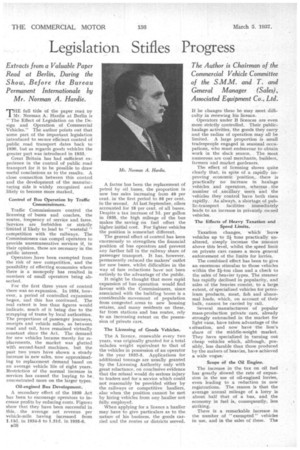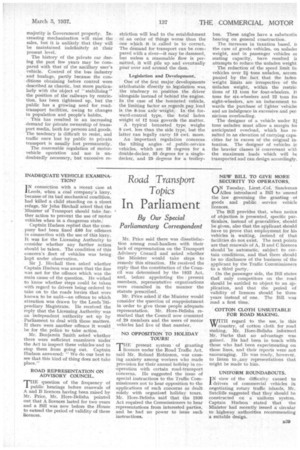Legislation Stifles Progress
Page 56

Page 57

If you've noticed an error in this article please click here to report it so we can fix it.
Extracts from a Valuable Paper Read at Berlin, During the Show, Before the Bureau Permanent Internationale by Mr. Norman A. Hardie.
HE full title of the paper read ey Mr. Norman A. Hardie at Berlin is " The Effect of Legislation on the Design and Operation of Commercial Vehicles." The author points out that some part of the important legislation introduced to secure efficient control of public road transport dates back to 1930, but as regards goods vehicles the greater part was introduced in 1933. • Great Britain has had sufficient experience in the control of public road transport for it to be possible to thaw useful conclusions as to the results. A close connection between this control and the development of the manufacturing side is widely recognized and likely to become more marked, Control of Bus Operation by Traffic Commissioners.
Traffic Commissioners control the licensing of buses and coaches, the routes, frequency of service and. fares. Services are forbidden or strictly -limited if likely to lead to ' wasteful " competition with the railways. The Commissioners can compel operators to provide unremunerative services if, in their opinion, these are necessary in the public interest.
Operators .have been exempted from the risk of new competition, and the possibility of effecting economies where there is a monopoly has resulted in numbers of small operators being absorbed.
For the first three years of control there was no expansion. In 1934, however, a period of controlled expansion began, and this has continued. The real extent is less than figures would indicate, much of it being due to the scrapping of trams by local authorities. The proportions of passenger journeys, receipts and vehicle miles, as between .road and rail, have remained virtually constant since the Act. The demand for new vehicles became merely for replacements, the market was glutted with second-hand .machines, but the past two years have shown a steady increase in new sales, now approximating to replacement demand based on an average vehicle life of eight years. Restriction of the normal increase in services has caused the buying to be, concentrated more on the larger types.
Oil-engined Bus Development.
A secondary effect of the 1930 Act has been to encourage operators to increase profits by reducing costs. Figures show that they have been successful in this,the average net revenue per *vehicle-miln having increased from 1.134. in 1934-5 to 1,31d. in 1935-6.
E38
A factor has been the replacement of petrol by oil buses, the proportion in new bus sales increasing from 49 per cent, in the first period to 56 per cent_ in the second. At last September, oilers accounted for 18 per cent, of all buses. Despite a tax increase of 7d. per gallon in 1935, the high mileage of the bus makes the saving on fuel offset the higher initial cost. For lighter vehicles the position is somewhat different.
The general effect of control has been enormously to strengthen the financial position of bus operators and prevent any further fall in the railway share of passenger transport. It has, however, permanently reduced the makers' outlet for new buses, whilst difficulties in the way of fare reductions havenot been entirely to the advantage of the public.
It might be thought that more rapid expansion of bus operation would find favour with the Commissioners, since associated with the building boom is a considerable movement of population from congested areas to new housing estates, and many residents on these, far from stations and bus routes, rely to an increasing extent on the possession of private cars.
The Licensing of Goods Vehicles.
The A licence, renewable every two years, was originally granted for a total unladen weight equivalent to that of the vehicles in possession of an operator in the year 1932-3. Applications for additional tonnage are usually granted by the Licensing Authority only with great reluctance, on conclusive evidence that the refusal would do serious injury to traders and for a service which could not reasonably be provided either by the railways or competitive hauliers, . also when the position cannot be met by hiring Vehicles from any haulier not fully employed.
When applying for a licence a haulier may have to give particulars as to the nature of his business, the 'goods carried and the routes or districts served. If he changes these be may meet difficulty in renewing his licence.
Operators under B licences are even more strictly controlled. Their publichaulage activities, the goods they carry and the radius of operation may all be limited, A large proportion is small tradespeople engaged in seasonal occupations, who must endeavour to obtain work in the slack season. . The most numerous are coal merchants, builders, farmers and market gardeners.
The effect of licensing shows quite clearly that, in spite of a rapidly improving •ecomimic position,, there is practically no increase in haulage vehicles and operators,, whereas tbe number of ancillary users and the vehicles they control have both risen rapidly. As always, a shortage of .public-transport facilities immediately leads to an increase in privately, owned vehicles,
The Effects of Heavy. Taxation and Speed Limits. •
Taxation changes, which 'leave vehicles up to 21 tons practically unaltered, steeply increase the -amount above this level, whilst the speed limit on priyate cars causes a more general enforcement of the limits for lorris.
The combined effect has been to give an enormous stimulus to those vehicles within the 21-ton class and a check to the sale's of heavier types. The steamer has rapidly declined in popularity, and sales of the heavies consist, to a large extent, of specialized vehicles for petroleum products, meat, fish and abnormal loads, which, on account of their bulk, cannot be carried by rail.
Several manufacturers of popular mass-production private cars, already strongly entrenched in the market for Tight vans, have taken advantage of the *situation, and now have the lion's share of the middle-weight market. They have specialized in turning out cheap vehicles which, although, possibly, less durable than those produced by the makers of heavies, have achieved a wide vogue: Scope of the Oil Engine.
The increase in the tax on oil fuel has greatly slowed the rate of expansion in the use of oil-engined lorries, even leading to a reduction in new registrations. The reason is that the average annual mileage of a lorry is about half that of a bus, and the economy in fuel is,, consequently, less striking.
h ere
T is a remarkable increase in the number of " exempted" vehicles in use, and in the sales of these. The
majority is Government property. Increasing mechanization will raise the sales, but it is unlikely that they will be maintained indefinitely at their present level.
The history of the private car during the past few years may be compared with that of the ancillary user's vehicle. Control of the bus industry and haulage, partly because the conditions obtaining before control were described as chaotic, but more particularly with the object of " stabilizing" the position of the railways by restriction, has been tightened up, but the public has a growing need for roadtransport facilities, owing to changes in population and people's habits.
• This has resulted in an increasing demand for private ownership of transport media, both for persons and goods. The tendency is difficult to resists, and traffic once lost by public to private transport is usually lost permanently.
The reasonable regulation of motorvehicle operation and use is undoubtedly necessary, but excessive re
striction will lead to the establishment of an order of things worse than the one which it is called in to correct. The demand for transport can be compared with a river—it may be dammed, but unless a reasonable flow is permated, it will pile up and eventually pour over and around the dam.
Legislation and Development.
One of the first major developments attributable dIrectly to legislation was, the tendency to position the driver alongside instead of behind the engine. In the case of the bonneted vehicle, the limiting factor as regards pay, load is the 8-ton axle weight. In the forward-control type, the total laden weight of 12 tons goverds the matter.
A typical bonneted type weighs 5 cwt. less than the side type, but the latter can legallY carry 10 cwt. more.
An important regulation concerns the tilting angles of public-service vehicles, which are 28 degrees for a double-decker, 35 degrees for a singledecker, and 25 decrees for a trolley
bus. These angles have a substantia bearing on general construction.
The increases in taxation based, ii the case of goods vehicles, on unlader weight, and in passenger vehicles oi seating capacity, have resulted is attempts to reduce the unladen weight
The reduction of the speed limit fol vehicles over 24. tons unladen, accom panied by the fact that the laden. weight limits are irrespective of tin Unladen weight, within the restric tions of 12 tons for four-wheelers, It tons for six-wheelers and 22 tons foi eight-wheelers, are an inducement towards the purchase of lighter vehiclef and an indulgence in excessive and pernicious overloading.
The designer of a vehicle under 21 tons unladen must allow a margin fin anticipated overload, which has resulted in an elevation of carrying capacities far in excess of the original intention. The designer of vehicles in the heavier classes is conversant with the maximum loads which will he transported and can design accordingly.




































































































